Walker J. Facies models, Canada, 1992
Подождите немного. Документ загружается.

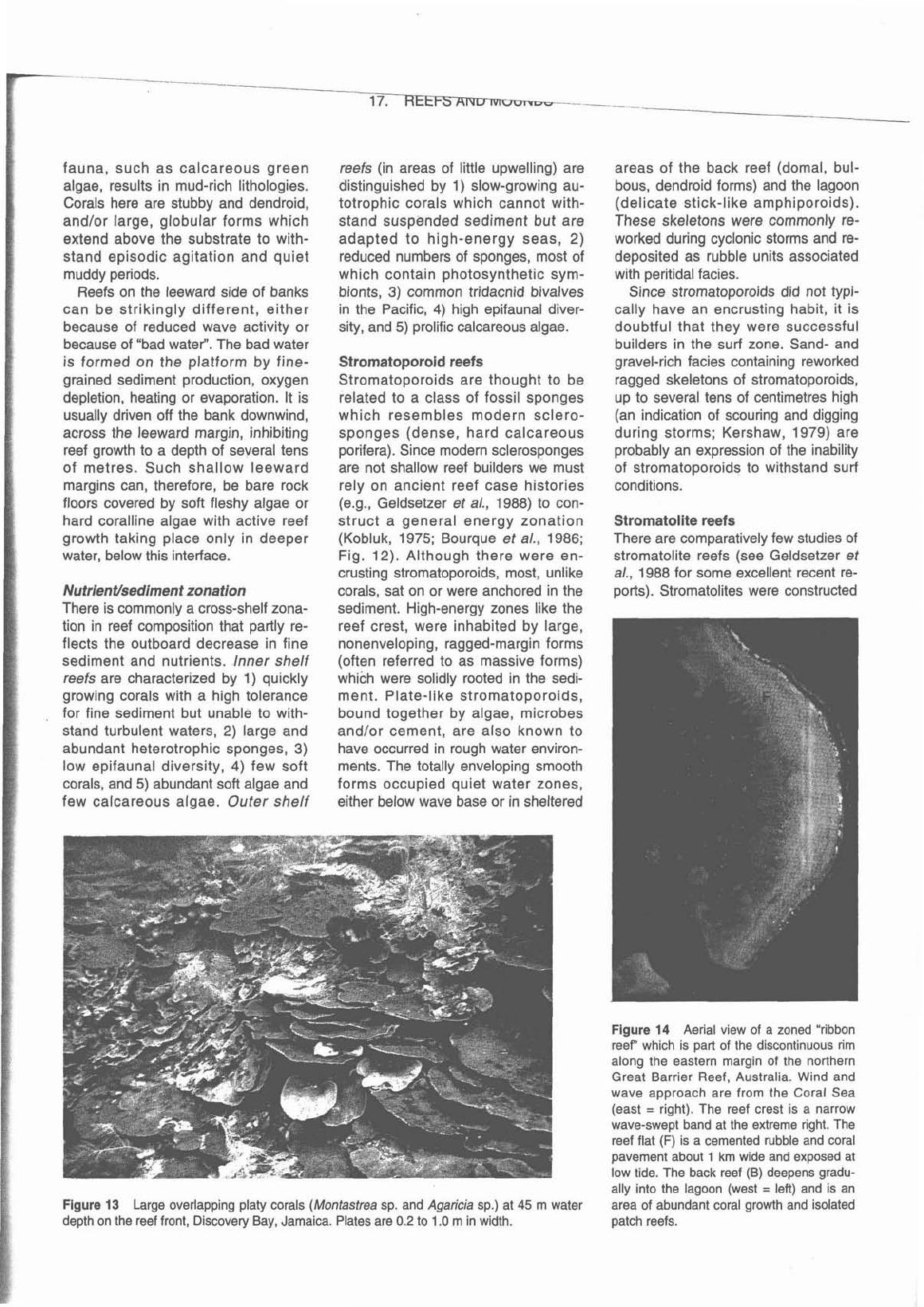
fauna, such as calcareous green
algae, results in mud-rich lithologies.
Corals here are stubby and dendroid,
and/or large, globular forms which
extend above the substrate to with-
stand episodic agitation and quiet
muddy periods.
Reefs on the leeward side of banks
can be strikingly different, either
because of reduced wave activity or
because of "bad water". The bad water
is formed on the platform by
fine-
grained sediment production, oxygen
depletion, heating or evaporation. It is
usually driven off the bank downwind,
across the leeward margin, inhibiting
reef growth to a depth of several tens
of metres. Such shallow leeward
margins can, therefore, be bare rock
floors covered by soft fleshy algae or
hard coralline algae with active reef
growth taking place only in deeper
water, below this interface.
Nutrlen Wsediment zonation
There is commonly a cross-shelf zona-
tion in reef composition that partly re-
flects the outboard decrease in fine
sediment and nutrients.
Inner shelf
reefs are characterized by 1) quickly
growing corals with a high tolerance
for fine sediment but unable to with-
stand turbulent waters, 2) large and
abundant heterotrophic sponges, 3)
low epifaunal diversity,
4)
few soft
corals, and
5)
abundant soft algae and
few calcareous algae. Outer shelf
reefs (in areas of little upwelling) are
distinguished by 1) slow-growing
au-
totrophic corals which cannot with-
stand suspended sediment but are
adapted to high-energy seas, 2)
reduced numbers of sponges, most of
which contain photosynthetic
sym-
bionts, 3) common tridacnid bivalves
in the Pacific,
4)
high epifaunal diver-
sity, and
5)
prolific calcareous algae.
Stromatoporoid reefs
Stromatoporoids are thought to be
related to a class of fossil sponges
which resembles modern
sclero-
sponges (dense, hard calcareous
porifera). Since modern sclerosponges
are not shallow reef builders we must
rely on ancient reef case histories
(e.g., Geldsetzer et al., 1988) to con-
struct a general energy zonation
(Kobluk, 1975; Bourque et al., 1986;
Fig. 12). Although there were en-
crusting stromatoporoids, most, unlike
corals, sat on or were anchored in the
sediment. High-energy zones like the
reef crest, were inhabited by large,
nonenveloping, ragged-margin forms
(often referred to as massive forms)
which were solidly rooted in the sedi-
ment. Plate-like stromatoporoids,
bound together by algae, microbes
and/or cement, are also known to
have occurred in rough water environ-
ments. The totally enveloping smooth
forms occupied quiet water zones,
either below wave base or in sheltered
Figure
13
Large overlapping platy corals
(Montastrea
sp. and
Agaricia
sp.) at
45
m water
depth on the reef front, Discovery Bay, Jamaica. Plates are 0.2 to 1.0 m in width.
areas of the back reef (domal, bul-
bous, dendroid forms) and the lagoon
(delicate stick-like amphiporoids).
These skeletons were commonly re-
worked during cyclonic storms and re-
deposited as rubble units associated
with peritidal facies.
Since stromatoporoids did not typi-
cally have an encrusting habit, it is
doubtful that they were successful
builders in the surf zone. Sand- and
gravel-rich facies containing reworked
ragged skeletons of stromatoporoids,
up to several tens of centimetres high
(an indication of scouring and digging
during storms; Kershaw, 1979) are
probably an expression of the inability
of stromatoporoids to withstand surf
conditions.
Stromatolite reefs
There are comparatively few studies of
stromatolite reefs (see Geldsetzer
et
a/., 1988 for some excellent recent re-
ports). Stromatolites were constructed
Figure
14
Aerial view of a zoned "ribbon
reef" which is part of the discontinuous rim
along the eastern margin of the northern
Great Barrier Reef, Australia. Wind and
wave approach are from the Coral Sea
(east
=
right). The reef crest is a narrow
wave-swept band at the extreme right. The
reef flat
(F)
is a cemented rubble and coral
pavement about 1 km wide and exposed at
low tide. The back reef (B) deepens gradu-
ally into the lagoon (west
=
left) and is an
area of abundant coral growth and isolated
patch reefs.
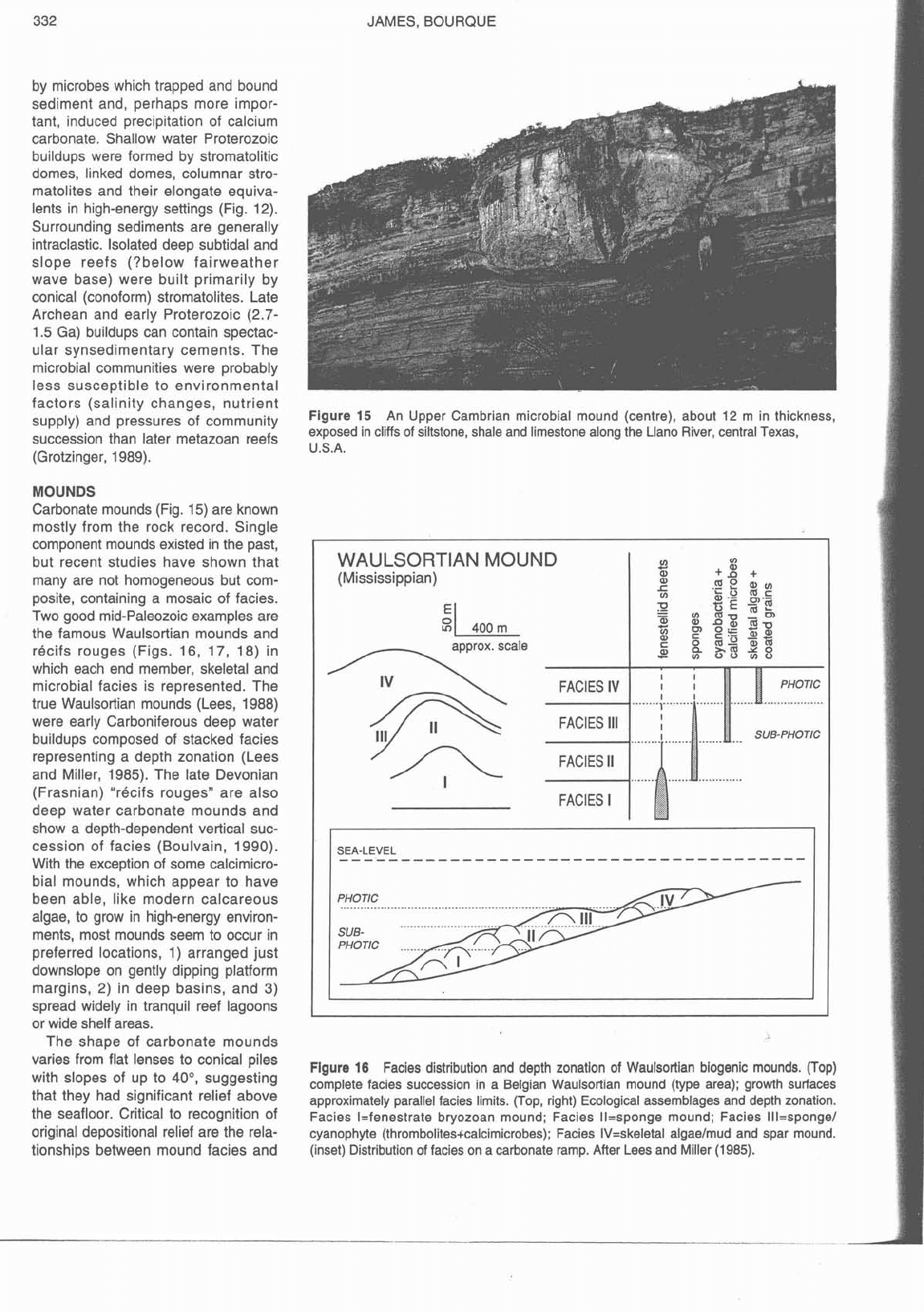
JAMES,
BOURQUE
by microbes which trapped and bound
sediment and, perhaps more impor-
tant, induced precipitation of calcium
carbonate. Shallow water Proterozoic
buildups were formed by stromatolitic
domes, linked domes, columnar
stro-
matolites and their elongate equiva-
lents in high-energy settings (Fig. 12).
Surrounding sediments are generally
intraclastic. Isolated deep
subtidal and
slope reefs (?below fairweather
wave base) were built primarily by
conical (conoform) stromatolites. Late
Archean and early Proterozoic (2.7-
1.5 Ga) buildups can contain spectac-
ular synsedimentary cements. The
microbial communities were probably
less susceptible to environmental
factors (salinity changes, nutrient
supply) and pressures of community
succession than later metazoan reefs
(Grotzinger, 1989).
MOUNDS
Carbonate mounds (Fig. 15) are known
mostly from the rock record. Single
component mounds existed in the past,
but recent studies have shown that
many are not homogeneous but com-
posite, containing a mosaic of facies.
Two good mid-Paleozoic examples are
the famous Waulsortian mounds and
r6cifs rouges (Figs. 16, 17, 18) in
which each end member, skeletal and
microbial facies is represented. The
true Waulsortian mounds (Lees, 1988)
were early Carboniferous deep water
buildups composed of stacked facies
representing a depth zonation (Lees
and Miller, 1985). The late Devonian
(Frasnian) "recifs rougesn are also
deep water carbonate mounds and
show a depth-dependent vertical suc-
cession of facies (Boulvain, 1990).
With the exception of some
calcimicro-
bial mounds, which appear to have
been able, like modern calcareous
algae, to grow in high-energy environ-
ments, most mounds seem to occur in
preferred locations,
1) arranged just
downslope on gently dipping platform
margins,
2)
in deep basins, and
3)
spread widely in tranquil reef lagoons
or wide shelf areas.
The shape of carbonate mounds
varies from flat lenses to conical piles
with slopes of up to
40°, suggesting
that they had significant relief above
the seafloor. Critical to recognition of
original depositional relief are the rela-
tionships between mound facies and
Figure
15
An Upper Cambrian microbial mound (centre), about
12
m in thickness,
exposed in cliffs of siltstone, shale and limestone along the Llano River, central Texas,
U.S.A.
WAULSORTIAN MOUND
3
In
(Mississippian)
w
w
+$
+
c
.m
2
a
a
U)
&
.s
g.s
400,
0
-
fjE
5%
s
.-.
82'0,~
U)
p
0,
0)
c.-
sB
approx. scale
g
!2
%%.$:
c
V)
00 U)0
FACIES IV
I
I
PHOTIC
........
FACIES
Ill
SUB-PHOTIC
"
..".
FACIES
I
SEA-LEVEL
......................................
PHOTIC
......
Figure
16
Facies distribution and depth zonation of Waulsortian biogenic mounds. (Top)
complete facies succession in a Belgian Waulsortian mound (type area); growth surfaces
approximately parallel facies limits. (Top, right) Ecological assemblages and depth zonation.
Facies
I=fenestrate bryozoan mound; Facies Il=sponge mound; Facies Ill=spongel
cyanophyte
(thrombolites+calcimicrobes);
Facies IV=skeletal algaelmud and spar mound.
(inset) Distribution of facies on a carbonate ramp. After Lees and Miller
(1985).
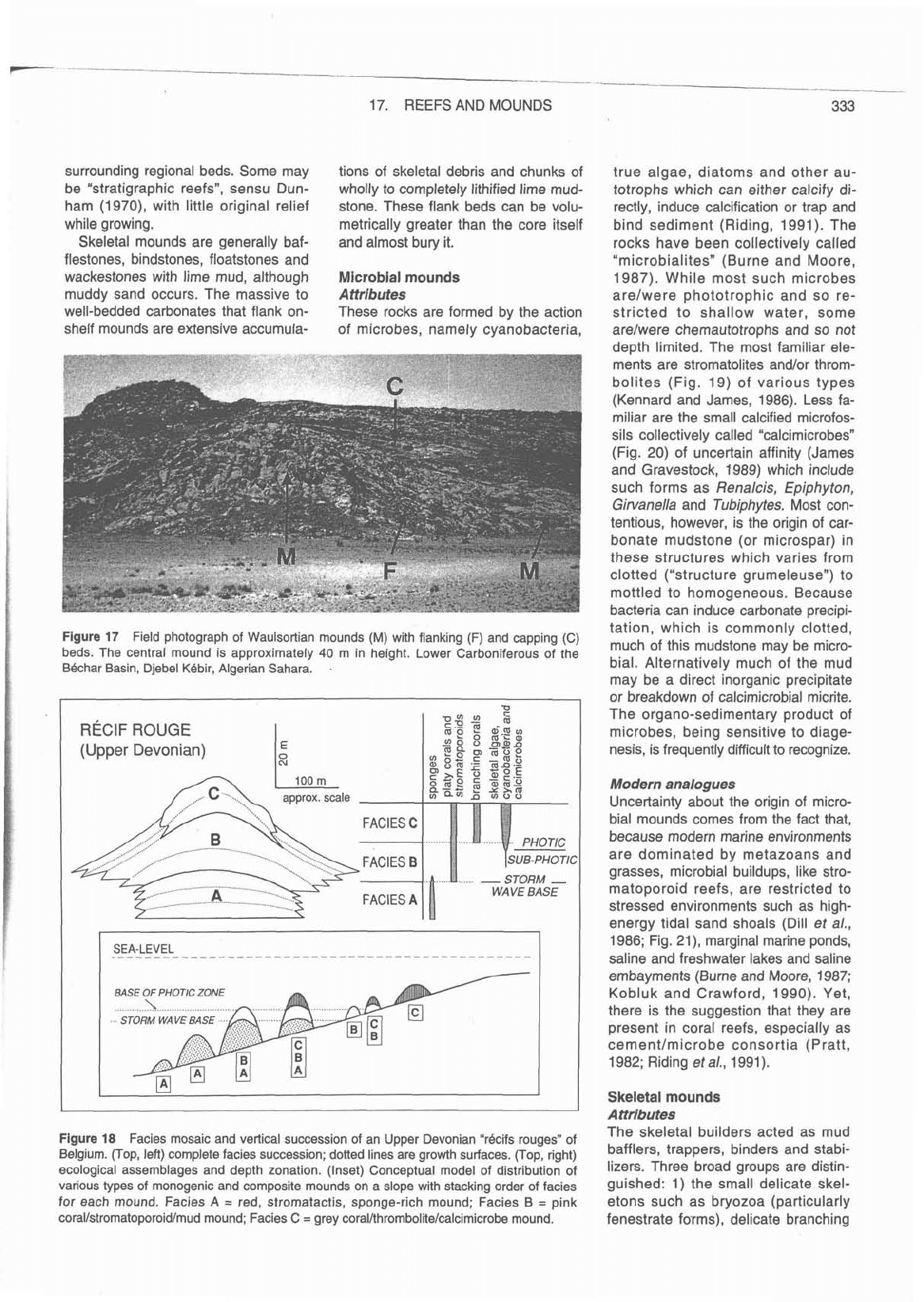
17. REEFS AND MOUNDS
333
surrounding regional beds. Some may
be "stratigraphic reefs", sensu
Dun-
ham (1970), with little original relief
while growing.
Skeletal mounds are generally
baf-
flestones, bindstones, floatstones and
wackestones with lime mud, although
muddy sand occurs. The massive to
well-bedded carbonates that flank
on-
shelf mounds are extensive accumula-
tions of skeletal debris and chunks of
wholly to completely
lithified lime mud-
stone. These flank beds can be volu-
metrically greater than the core itself
and almost bury it.
Microbial
mounds
Attributes
These rocks are formed by the action
of microbes, namely cyanobacteria,
Figure
17
Field photograph of Waulsortian mounds
(M)
with flanking (F) and capping (C)
beds. The central mound is approximately
40
m in height. Lower Carboniferous of the
BBchar Basin, Djebel KBbir, Algerian Sahara.
.
R~CIF
ROUGE
(Upper Devonian)
-
STORM
-
WAVE
BASE
BASE
OF PHOTlC
ZONE
. .
.
. . . .
.
. .
.
b..
.
.
. .
.
.
.
.
. .
.
.
.
. . .
.
.
.
. .
.
.
.
.
.
Figure
18
Facies mosaic and vertical succession of an Upper Devonian "rbcifs rouges" of
Belgium. (Top, left) complete facies succession; dotted lines are growth surfaces. (Top, right)
ecological assemblages and depth zonation. (Inset) Conceptual model of distribution of
various types of monogenic and composite mounds on a slope with stacking order of facies
for each mound. Facies
A
=
red, stromatactis, sponge-rich mound; Facies B
=
pink
coral/stromatoporoid/mud
mound; Facies C
=
grey
coral/thrombolite/calcimicrobe
mound.
true algae, diatoms and other au-
totrophs which can either calcify di-
rectly, induce calcification or trap and
bind sediment (Riding, 1991). The
rocks have been collectively called
"microbialites" (Burne and Moore,
1987). While most such microbes
arelwere phototrophic and so re-
stricted to shallow water, some
arelwere chemautotrophs and so not
depth limited. The most familiar ele-
ments are stromatolites
andlor throm-
bolites (Fig. 19) of various types
(Kennard and James, 1986). Less fa-
miliar are the small calcified
microfos-
sils collectively called "calcimicrobes"
(Fig. 20) of uncertain affinity (James
and Gravestock, 1989) which include
such forms as
Renalcis, Epiphyton,
Girvanella and Tubiphytes. Most con-
tentious, however, is the origin of car-
bonate
mudstone (or microspar) in
these structures which varies from
clotted ("structure grumeleusen) to
mottled to homogeneous. Because
bacteria can induce carbonate precipi-
tation, which is commonly clotted,
much of this
mudstone may be micro-
bial. Alternatively much of the mud
may be a direct inorganic precipitate
or breakdown of calcimicrobial micrite.
The organo-sedimentary product of
microbes, being sensitive to
diage-
nesis, is frequently difficult to recognize.
Modern analogues
Uncertainty about the origin of micro-
bial mounds comes from the fact that,
because modern marine environments
are dominated by metazoans and
grasses, microbial buildups, like
stro-
matoporoid reefs, are restricted to
stressed environments such as
high-
energy tidal sand shoals (Dill et a/.,
1986; Fig.
21),
marginal marine ponds,
saline and freshwater lakes and saline
embayments (Burne and Moore, 1987;
Kobluk and Crawford, 1990). Yet,
there is the suggestion that they are
present
in
coral reefs, especially as
cementlmicrobe consortia (Pratt,
1982; Riding etal., 1991).
Skeletal
mounds
Attributes
The skeletal builders acted as mud
bafflers, trappers, binders and stabi-
lizers. Three broad groups are distin-
guished:
I) the small delicate skel-
etons such as bryozoa (particularly
fenestrate farms), delicate branching
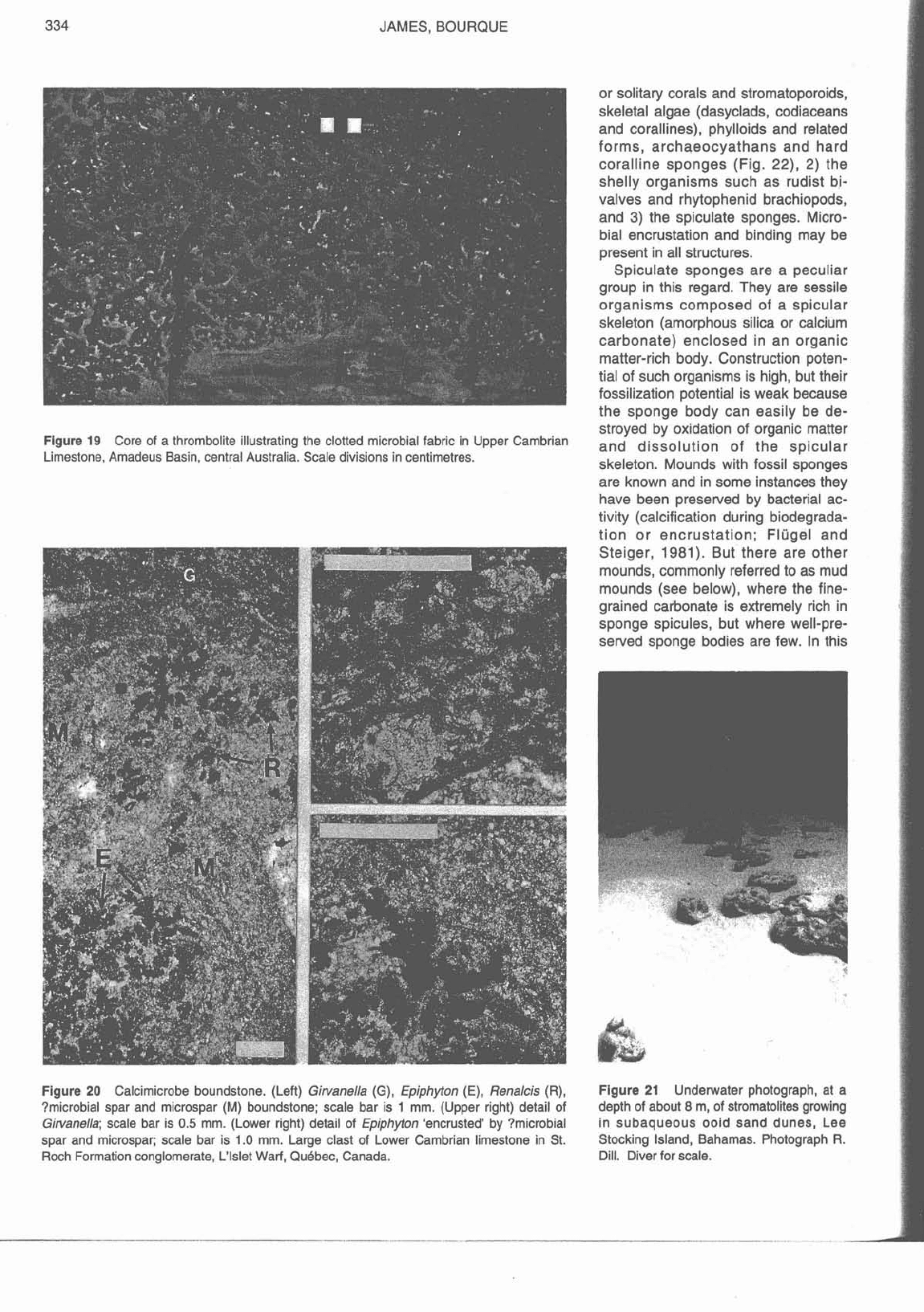
334
JAMES,
BOURQUE
or solitary corals and stromatoporoids,
skeletal algae (dasyclads, codiaceans
and corallines), phylloids and related
forms, archaeocyathans and hard
coralline sponges (Fig.
22),
2)
the
shelly organisms such as rudist bi-
valves and rhytophenid brachiopods,
and
3)
the spiculate sponges. Micro-
bial encrustation and binding may be
present in all structures.
Spiculate sponges are a peculiar
group in this regard. They are sessile
organisms composed of a spicuiar
skeleton (amorphous silica or calcium
carbonate) enclosed in an organic
matter-rich body. Construction poten-
tial of such organisms is high, but their
fossilization potential is weak because
the sponge body can easily be de-
stroyed by oxidation of organic matter
Figure
19
Core of a thrombolite illustrating the clotted microbial fabric in Upper Cambrian
and
dissolution
of
the
spicular
Limestone, Amadeus Basin, central Australia. Scale divisions in centimetres.
skeleton. Mounds with fossil sponges
are known and in some instances they
have been preserved by bacterial ac-
tivity (calcification during biodegrada-
tion or encrustation;
Flugel and
Steiger,
1981).
But there are other
mounds, commonly referred to as mud
mounds (see below), where the fine-
grained carbonate is extremely rich in
sponge spicules, but where well-pre-
served sponge bodies are few. In this
Figure
20
Calcirnicrobe boundstone. (Left) Girvanella
(G),
Epiphyton
(E),
Renalcis (R),
Figure
21
Underwater photograph, at a
?microbial spar and microspar
(M)
boundstone; scale bar is
1
mm. (Upper right) detail of
depth of about
8
m, of stromatolites growing
Girvanella; scale bar is
0.5
mm. (Lower right) detail of Epiphyton 'encrusted' by ?microbial
in subaqueous ooid sand dunes, Lee
spar and microspar; scale bar is
1.0
mm. Large clast of Lower Cambrian limestone in St.
Stocking Island, Bahamas. Photograph R.
Roch Formation conglomerate,
L'lslet Warf, QuBbec, Canada.
Dill. Diver for scale.
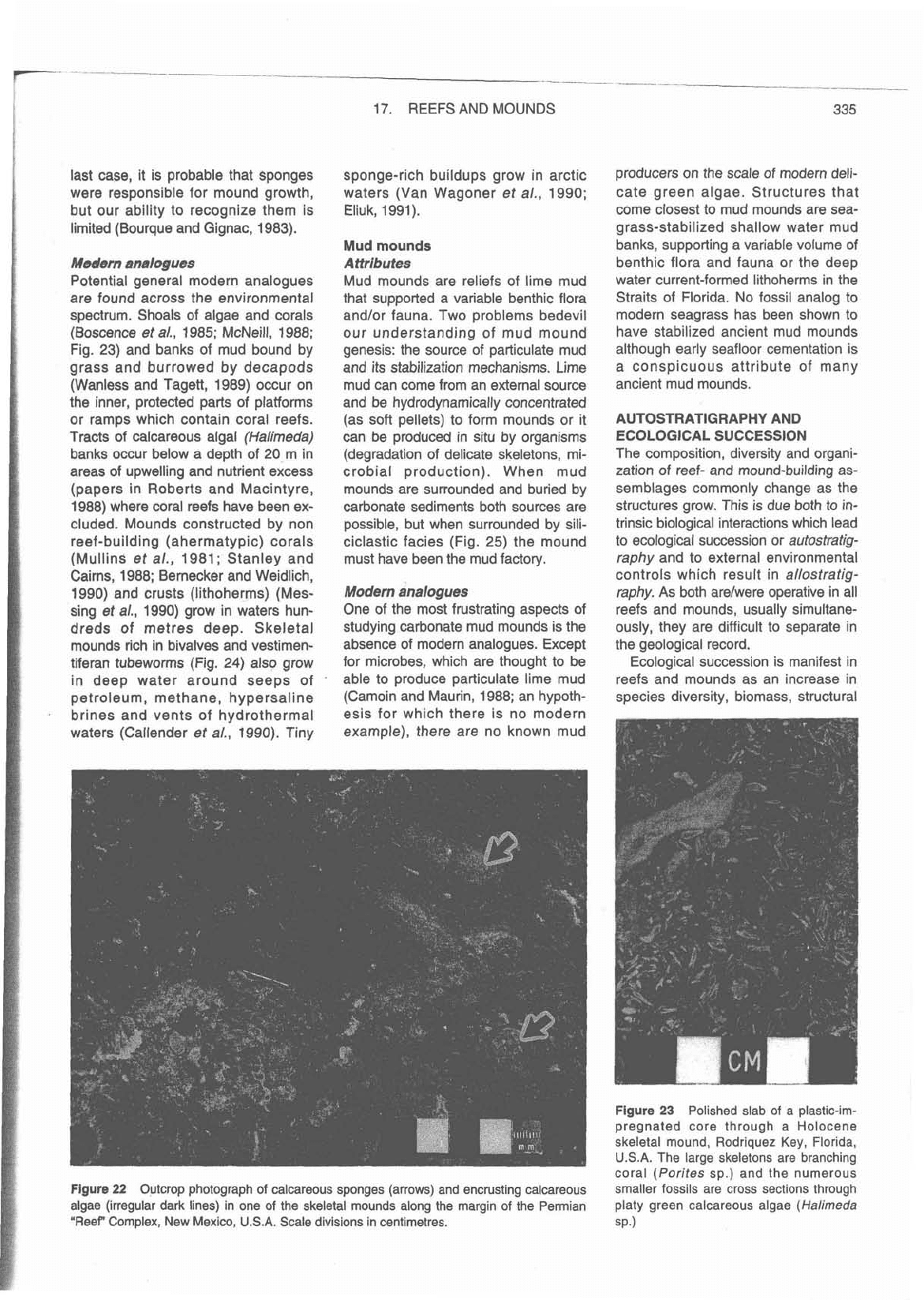
last case, it is probable that sponges
were responsible for mound growth,
but our ability to recognize them is
limited (Bourque and Gignac, 1983).
Msdern
annloglues
Potential general modern analogues
are found across the environmental
spectrum. Shoals of algae and corals
(Boscence
et
a/., 1985; McNeill, 1988;
Fig. 23) and banks of mud bound by
grass and burrowed by decapods
(Wanless and Tagett, 1989) occur on
the inner, protected parts of platforms
or ramps which contain coral reefs.
Tracts of calcareous algal
(Halimeda)
banks occur below a depth of 20 m in
areas of upwelling and nutrient excess
(papers in Roberts and Macintyre,
1988) where coral reefs have been ex-
cluded. Mounds constructed by non
reef-building (ahermatypic) corals
(Mullins et a/., 1981; Stanley and
Cairns, 1988; Bernecker and Weidlich,
1990) and crusts (lithoherms) (Mes-
sing et
a/.,
1990) grow in waters hun-
dreds of metres deep. Skeletal
mounds rich in bivalves and
vestimen-
tiferan tubeworms (Fig. 24) also grow
in deep water around seeps of
petroleum, methane,
hv~ersaline
17. REEFS AND MOUNDS
sponge-rich buildups grow in arctic
waters (Van Wagoner et al., 1990;
Eliuk, 1991).
Mud
mounds
Attributes
Mud mounds are reliefs of lime mud
that supported a variable benthic flora
and/or fauna. Two problems bedevil
our understanding of mud mound
genesis: the source of particulate mud
and its stabilization mechanisms. Lime
mud can come from an external source
and be hydrodynamically concentrated
(as soft pellets) to form mounds or it
can be produced in situ by organisms
(degradation of delicate skeletons, mi-
crobial production). When mud
mounds are surrounded and buried by
carbonate sediments both sources are
possible, but when surrounded by
sili-
ciclastic facies (Fig. 25) the mound
must have been the mud factory.
Modern analogues
One of the most frustrating aspects of
studying carbonate mud mounds is the
absence of modern analogues. Except
for microbes, which are thought to be
able to produce particulate lime mud
(Camoin and Maurin, 1988; an
hypoth-
producers on the scale of modern deli-
cate green algae. Structures that
come closest to mud mounds are sea-
grass-stabilized shallow water mud
banks, supporting a variable volume of
benthic flora and fauna or the deep
water current-formed lithoherms in the
Straits of Florida. No fossil analog to
modern
seagrass has been shown to
have stabilized ancient mud mounds
although early
seafloor cementation is
a conspicuous attribute of many
ancient mud mounds.
AUTOSTRATIGRAPHY AND
ECOLOGICAL SUCCESSION
The composition, diversity and organi-
zation of reef- and mound-building
as-
semblages commonly change as the
structures grow. This is due both to in-
trinsic biological interactions which lead
to ecological succession or
autostratig-
raphy and to external environmental
controls which result in
allostratig-
raphy. As both arelwere operative in all
reefs and mounds, usually simultane-
ously, they are difficult to separate in
the geological record.
Ecological succession is manifest in
reefs and mounds as an increase in
species diversity, biomass, structural
brines and vents of
hyd;othermal
esis for which there is no modern
waters (Callender et
a/., 1990). Tiny
example), there are no known mud
Figure
23
Polished slab
of
a plastic-im-
pregnated core through a Holocene
skeletal mound, Rodriquez Key, Florida,
U.S.A.
The
large
skeletons
are
branching
coral (Porites
sp.)
and the numerous
Figure
22
Outcrop photograph of calcareous sponges (arrows) and encrusting calcareous
smaller fossils are cross sections through
algae (irregular dark lines) in one of the skeletal mounds along the margin of the Permian platy green calcareous algae (Halimeda
"ReeP" Complex, New Mexico,
USA.
Scale divisions in centimetres.
sp.1
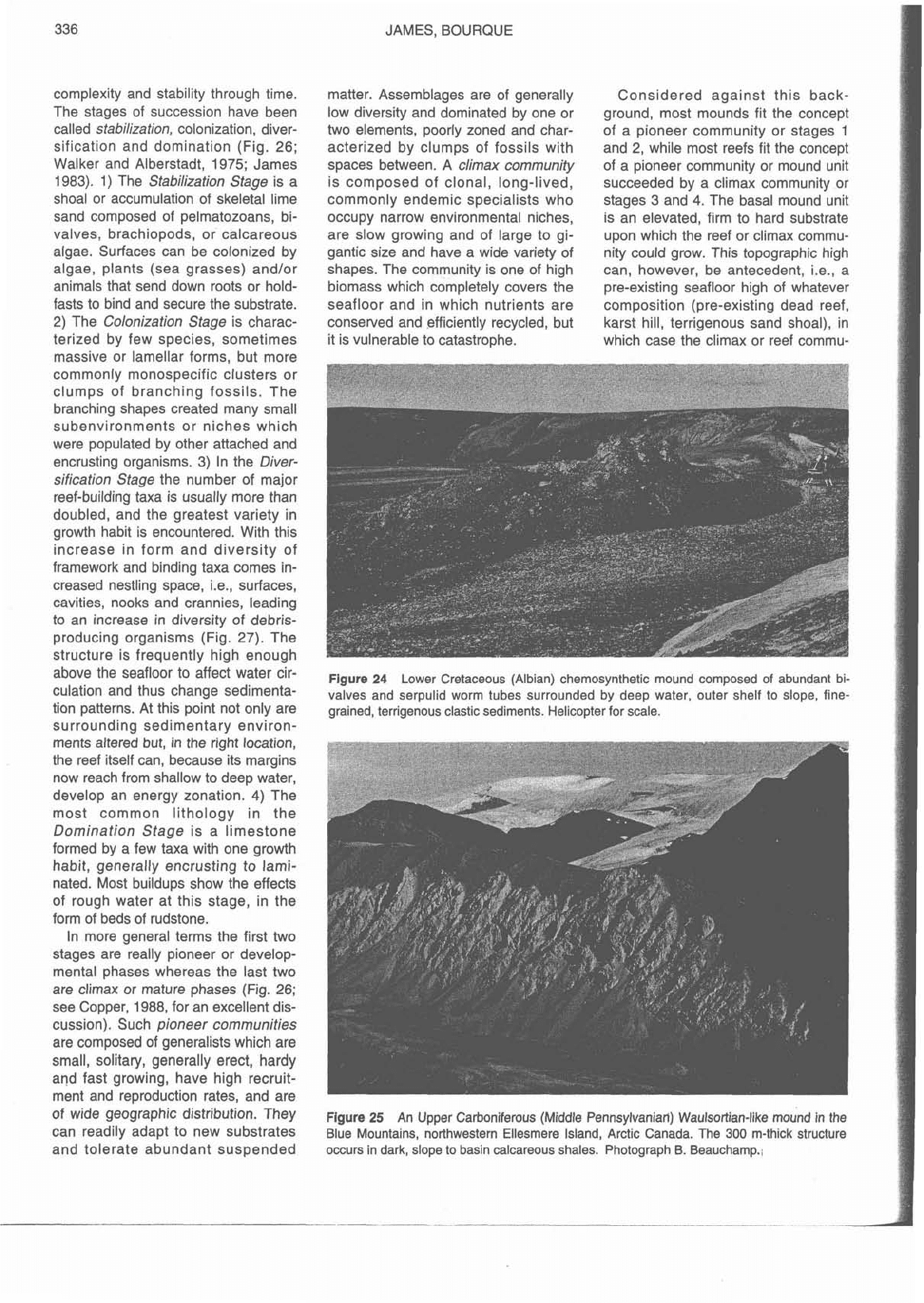
336 JAMES, BOURQUE
complexity and stability through time.
The stages of succession have been
called stabilization, colonization, diver-
sification and domination (Fig. 26;
Walker and Alberstadt, 1975; James
1983).
1)
The Stabilization Stage is a
shoal or accumulation of skeletal lime
sand composed of
pelmatozoans, bi-
valves, brachiopods, or calcareous
algae. Surfaces can be colonized by
algae, plants (sea grasses)
and/or
animals that send down roots or hold-
fasts to bind and secure the substrate.
2)
The Colonization Stage is charac-
terized by few species, sometimes
massive or lamellar forms, but more
commonly monospecific clusters or
clumps of branching fossils. The
branching shapes created many small
subenvironments or niches which
were populated by other attached and
encrusting organisms. 3) In the Diver-
sification Stage the number of major
reef-building taxa is usually more than
doubled, and the greatest variety in
growth habit is encountered. With this
increase in form and diversity of
framework and binding taxa comes in-
creased nestling space,
i.e., surfaces,
cavities, nooks and crannies, leading
to an increase in diversity of
debris-
producing organisms (Fig.
27).
The
structure is frequently high enough
matter. Assemblages are of generally
low diversity and dominated by one or
two elements, poorly zoned and char-
acterized by clumps of fossils with
spaces between. A climax community
is composed of clonal, long-lived,
commonly endemic specialists who
occupy narrow environmental niches,
are slow growing and of large to gi-
gantic size and have a wide variety of
shapes. The community is one of high
biomass which completely covers the
seafloor and in which nutrients are
conserved and efficiently recycled, but
it is vulnerable to catastrophe.
Considered against this back-
ground, most mounds fit the concept
of a pioneer community or stages
1
and
2,
while most reefs fit the concept
of a pioneer community or mound unit
succeeded by a climax community or
stages 3 and
4.
The basal mound unit
is an elevated, firm to hard substrate
upon which the reef or climax commu-
nity could grow. This topographic high
can, however, be antecedent,
i.e., a
pre-existing
seafloor high of whatever
composition (pre-existing dead reef,
karst hill, terrigenous sand shoal), in
which case the climax or reef
commu-
above
the
seafloor
water
'jr-
Figure
24
Lower Cretaceous (Albian) chemosynthetic mound composed of abundant
bi-
culatiOn
and
thus
change
sedimentam
valves and serpulid worm tubes surrounded by deep water, outer shelf to slope, fine-
tion Patterns. At this point not only are
grained, terrigenous clastic sediments. Helicopter for scale.
surrounding sedimentary environ-
ments altered but, in the
right location,
the reef itself can, because its margins
now reach from shallow to deep water,
develop an energy zonation.
4)
The
most common lithology in the
Domination Stage is a limestone
formed by a few taxa with one growth
habit, generally encrusting to lami-
nated. Most buildups show the effects
of rough water at this stage, in the
form of beds of rudstone.
In more general terms the first two
stages are really pioneer or develop-
mental phases whereas the last two
are climax or mature phases (Fig.
26;
see Copper, 1988, for an excellent dis-
cussion). Such pioneer communities
are composed of generalists which are
small, solitary, generally erect, hardy
and fast growing, have high recruit-
ment and
re~roduction rates, and are
of wide geographic distribution. They
Figure
25
An Upper Carboniferous (Middle Pennsylvsniarl) Waulsortian-like mound in the
can readily adapt
to new substrates
Blue Mountains, northwestern Ellesmere Island, Arctic Canada. The
300
rn-thick structure
and tolerate abundant suspended occurs in dark, slope to basin calcareous shales. Photograph
6. Beauchamp.,
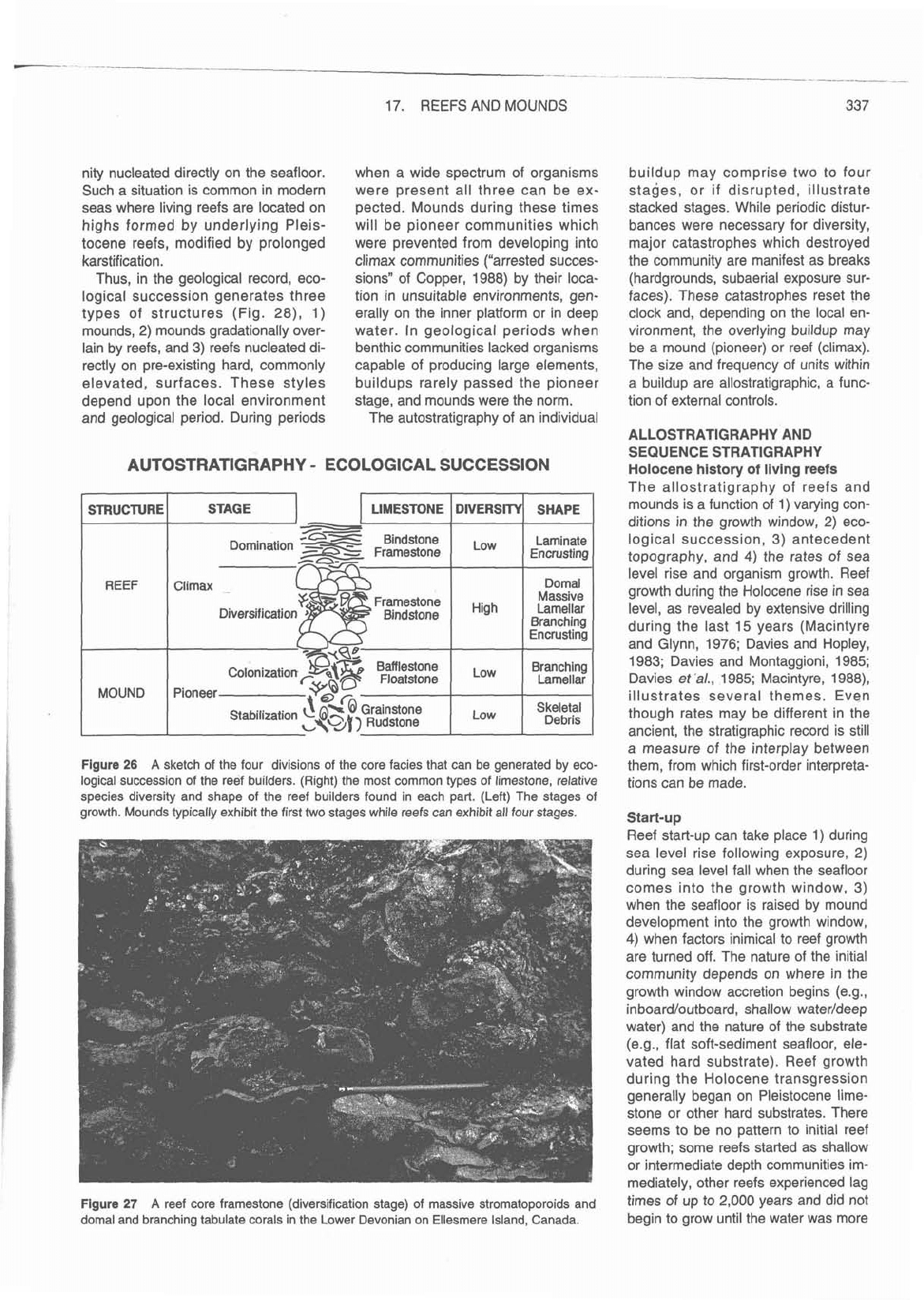
17. REEFS AND MOUNDS 337
nity nucleated directly on the seafloor.
Such a situation is common in modern
seas where living reefs are located on
highs formed by underlying Pleis-
tocene reefs, modified by prolonged
karstification.
Thus, in the geological record, eco-
logical succession generates three
types of structures (Fig.
28), 1)
mounds, 2) mounds gradationally over-
lain by reefs, and 3) reefs nucleated di-
rectly on pre-existing hard, commonly
elevated, surfaces. These styles
depend upon the local environment
and geological period. During periods
when a wide spectrum of organisms
were present all three can be ex-
pected. Mounds during these times
will be pioneer communities which
were prevented from developing into
climax communities ("arrested succes-
sions" of Copper, 1988) by their loca-
tion in unsuitable environments, gen-
erally on the inner platform or in deep
water. In geological periods when
benthic communities lacked organisms
capable of producing large elements,
buildups rarely passed the pioneer
stage, and mounds were the norm.
The autostratigraphy of an individual
AUTOSTRATIGRAPHY
-
ECOLOGICAL SUCCESSION
buildup may comprise two to four
stages, or if disrupted, illustrate
stacked stages. While periodic distur-
bances were necessary for diversity,
major catastrophes which destroyed
the community are manifest as breaks
(hardgrounds, subaerial exposure sur-
faces). These catastrophes reset the
clock and, depending on the local en-
vironment, the overlying buildup may
be a mound (pioneer) or reef (climax).
The size and frequency of units within
a buildup are allostratigraphic, a func-
tion of external controls.
ALLOSTRATIGRAPHY
AND
SEQUENCE STRATIGRAPHY
Holocene history of living reefs
The
allostratig;aphy of reefs and
mounds is a function of
1)
varying con-
ditions in the growth window, 2) eco-
logical succession,
3)
antecedent
topography, and
4)
the rates of sea
level rise and organism growth. Reef
growth during the Holocene rise in sea
level, as revealed by extensive drilling
during the last 15 years (Macintyre
and Glynn, 1976; Davies and Hopley,
1983; Davies and Montaggioni, 1985;
Davies
et'al.,
1985; Macintyre, 1988),
illustrates several themes. Even
though rates may be different in the
I
ancient, the stratigraphic record is still
a measure of the interplay between
Figure
26
A
sketch of the four divisions
of
the core facies that can be generated by eco-
them, from which first-order interpreta-
logical succession of the reef builders. (Right) the most common types
of limestone, relative
tions
can be made,
species diversity and shape of the reef builders found in each part. (Left) The stages of
growth. Mounds typically exhibit the first two stages while reefs can exhibit all four stages.
Start-up
Reef start-up can take place
1)
during
sea level rise following exposure, 2)
during sea level fall when the
seafloor
comes into the growth window, 3)
when the
seafloor is raised by mound
development into the growth window,
4)
when factors inimical to reef growth
are turned off. The nature of the initial
community depends on where in the
growth window accretion begins
(e.g.,
inboard/outboard, shallow waterldeep
water) and the nature of the substrate
(e.g., flat soft-sediment seafloor, ele-
vated hard substrate). Reef growth
during the Holocene transgression
generally began on Pleistocene lime-
stone or other hard substrates. There
seems to be no pattern to initial reef
growth; some reefs started as shallow
or intermediate depth communities im-
mediatelv, other reefs experienced lag
7
-
Flgure
27
A
reef core framestone (diversification stage) of massive stromatoporoids and
times of up to
2,000
years and did not
dornal and branching tabulate corals in the Lower Devonian on Ellesmere Island, Canada.
begin to grow until the water was more
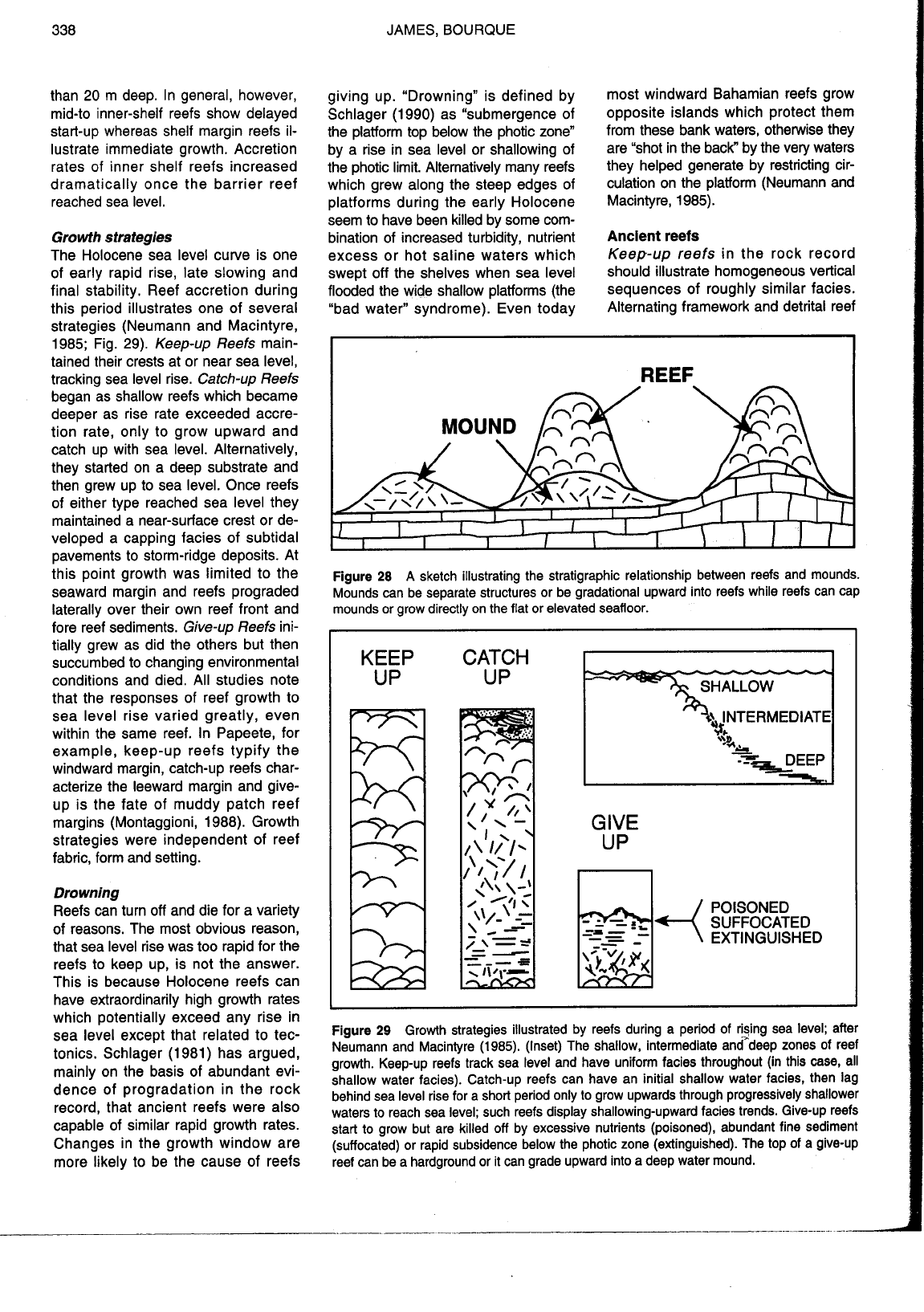
338 JAMES, BOURQUE
than 20 m deep. In general, however,
mid-to inner-shelf reefs show delayed
start-up whereas shelf margin reefs il-
lustrate immediate growth. Accretion
rates
of
inner shelf reefs increased
dramatically once the barrier reef
reached sea level.
Growth strategies
The Holocene sea level curve is one
of early rapid rise, late slowing and
final stability. Reef accretion during
this period illustrates one of several
strategies (Neumann and Macintyre,
1985; Fig. 29).
Keep-up Reefs
main-
tained their crests at or near sea level,
tracking sea level rise.
Catch-up Reefs
began as shallow reefs which became
deeper as rise rate exceeded accre-
tion rate, only to grow upward and
catch up with sea level. Alternatively,
they started on a deep substrate and
then grew up to sea level. Once reefs
of either type reached sea level they
maintained a near-surface crest or de-
veloped a capping facies of
subtidal
pavements to storm-ridge deposits. At
this point growth was limited to the
seaward margin and reefs prograded
laterally over their own reef front and
fore reef sediments.
Give-up Reefs
ini-
tially grew as did the others but then
succumbed to changing environmental
conditions and died. All studies note
that the responses of reef growth to
sea level rise varied greatly, even
within the same reef. In Papeete, for
example, keep-up reefs typify the
windward margin, catch-up reefs char-
acterize the leeward margin and
give-
up is the fate of muddy patch reef
margins (Montaggioni, 1988). Growth
strategies were independent of reef
fabric, form and setting.
Drowning
Reefs can turn off and die for a variety
of reasons. The most obvious reason,
that sea level rise was too rapid for the
reefs to keep up, is not the answer.
This is because Holocene reefs can
have extraordinarily high growth rates
which potentially exceed any rise in
sea level except that related to tec-
tonics. Schlager (1981) has argued,
mainly on the basis of abundant evi-
dence of progradation in the rock
record, that ancient reefs were also
capable of similar rapid growth rates.
Changes in the growth window are
more likely to be the cause of reefs
giving up. "Drowning" is defined by
Schlager (1990) as "submergence of
the platform top below the photic zonen
by a rise in sea level or shallowing of
the photic limit. Alternatively many reefs
which grew along the steep edges of
platforms during the early Holocene
seem to have been killed by some com-
bination of increased turbidity, nutrient
excess or hot saline waters which
swept off the shelves when sea level
flooded the wide shallow platforms (the
"bad water" syndrome). Even today
most windward Bahamian reefs grow
opposite islands which protect them
from these bank waters, otherwise they
are "shot in the back" by the very waters
they helped generate by restricting cir-
culation on the platform (Neumann and
Macintyre, 1985).
Ancient reefs
Keep-up reefs
in the rock record
should illustrate homogeneous vertical
sequences of roughly similar facies.
Alternating framework and detrital reef
Figure
28
A
sketch illustrating the stratigraphic relationship between reefs and mounds.
Mounds can be separate structures or be gradational upward into reefs while reefs can cap
mounds or grow directly on the flat or elevated seafloor.
KEEP
CATCH
UP
UP
-
7
---DEEP
GIVE
UP
POISONED
SUFFOCATED
EXTINGUISHED
Figure
29
Growth strategies illustrated by reefs during a period of r$ing sea level; after
Neumann and Macintyre
(1985).
(Inset) The shallow, intermediate and deep zones of reef
growth. Keep-up reefs track sea level and have uniform facies throughout (in this case, all
shallow water facies). Catch-up reefs can have an initial shallow water facies, then lag
behind sea level rise for a short period only to grow upwards through progressively shallower
waters to reach sea level; such reefs display shallowing-upward facies trends. Give-up reefs
start to grow but are killed off by excessive nutrients (poisoned), abundant fine sediment
(suffocated) or rapid subsidence below the photic zone (extinguished). The top of a give-up
reef can be a hardground or it can grade upward into a deep water mound.
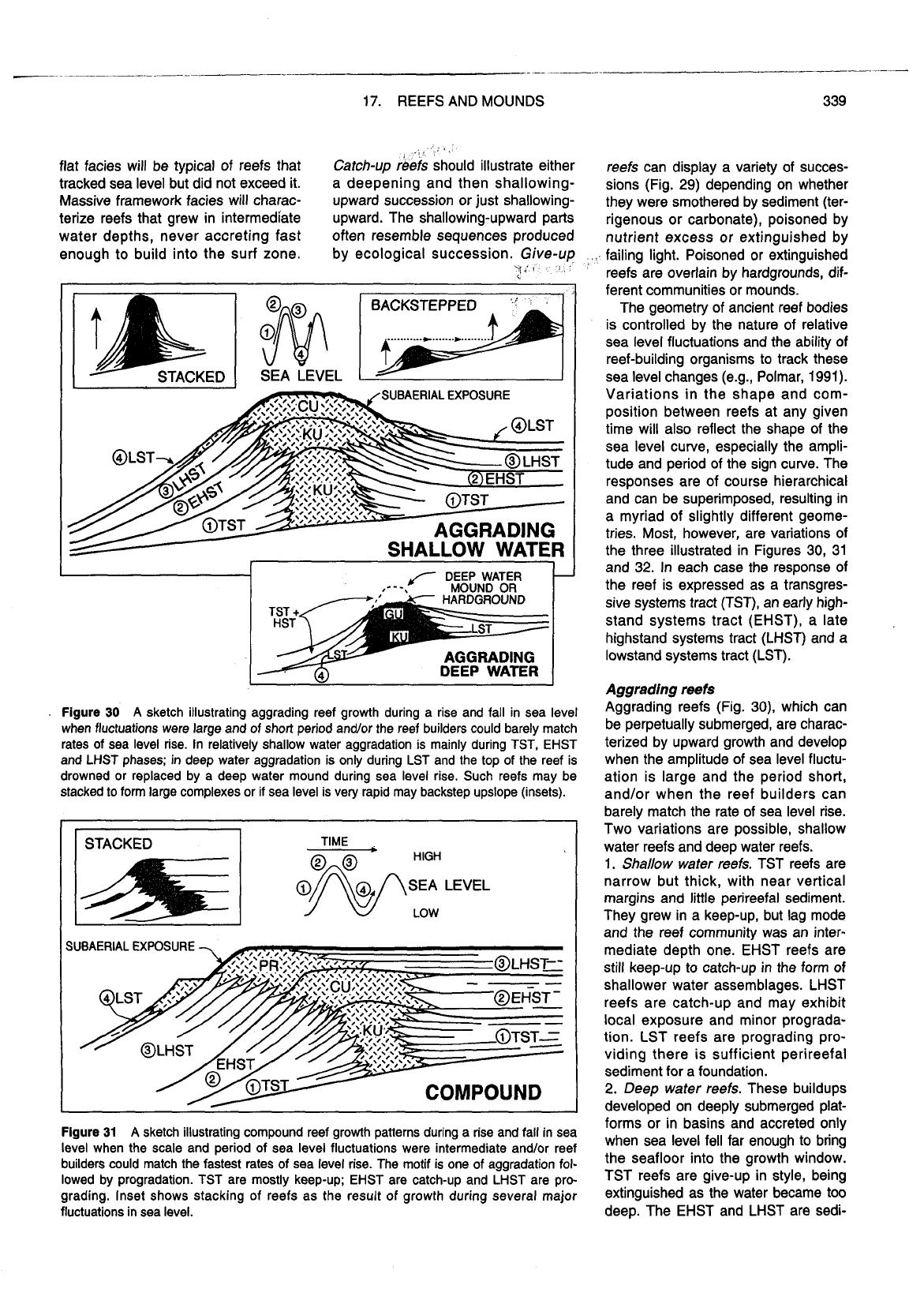
17.
REEFS AND MOUNDS 339
flat facies will be typical of reefs that
Catch-up reefs should illustrate either
reefs can display a variety of succes-
tracked sea level but did not exceed it.
a deepening and then
shallowing-
sions (Fig.
29)
depending on whether
Massive framework facies will charac- upward succession or just
shallowing-
they were smothered by sediment (ter-
terize reefs that grew in intermediate
upward. The
shallowing-upward parts
rigenous or carbonate), poisoned by
water depths, never accreting fast often resemble sequences produced
nutrient excess or extinguished by
enough to build into the surf zone.
by ecological succession. Give-up
failing light. Poisoned or extinguished
b
C
reefs are overlain bv hardqrounds, dif-
Figure
30
A
sketch illustrating aggrading reef growth during a rise and fall in sea level
when fluctuations were large and of short period
and/or the
reef
builders could barely match
rates of sea level rise. In relatively shallow water aggradation is mainly during TST, EHST
and LHST phases; in deep water aggradation is only during LST and the top of the reef is
drowned or replaced by a deep water mound during sea level rise. Such reefs may be
stacked to form large complexes or if sea level is very rapid may
backstep upslope (insets).
Figure
31
A
sketch illustrating compound reef growth patterns during a rise and fall in sea
level when the scale and period of sea level fluctuations were intermediate and/or reef
builders could match the fastest rates of sea level rise. The motif is one of aggradation fol-
lowed by progradation. TST are mostly keep-up; EHST are catch-up and LHST are pro-
grading, Inset shows stacking of reefs as the result of growth during several major
fluctuations in sea level.
ferent communities or mounds.
The geometry of ancient reef bodies
is controlled by the nature of relative
sea level fluctuations and the ability of
reef-building organisms to track these
sea level changes
(e.g., Polmar, 1991).
Variations in the shape and com-
position between reefs at any given
time will also reflect the shape of the
sea level curve, especially the ampli-
tude and period of the sign curve. The
responses are of course hierarchical
and can be superimposed, resulting in
a myriad of slightly different geome-
tries. Most, however, are variations of
the three illustrated in Figures 30, 31
and
32.
In each case the response of
the reef is expressed as a transgres-
sive systems tract (TST), an early
high-
stand systems tract (EHST), a late
highstand systems tract (LHST) and a
lowstand systems tract (LST).
Aggrading
reefs
Aggrading reefs (Fig. 30), which can
be perpetually submerged, are charac-
terized by upward growth and develop
when the amplitude of sea level fluctu-
ation is large and the period short,
and/or when the reef builders can
barely match the rate of sea level rise.
Two variations are possible, shallow
water reefs and deep water reefs.
1.
Shallow water reefs. TST reefs are
narrow but thick, with near vertical
margins and little
perireefal sediment.
They grew in a keep-up, but lag mode
and the reef community was an inter-
mediate depth one.
EHST
reefs are
still keep-up to catch-up in the form of
shallower water assemblages. LHST
reefs are catch-up and may exhibit
local exposure and minor
prograda-
tion. LST reefs are prograding pro-
viding there is sufficient
perireefal
sediment for a foundation.
2.
Deep water reefs. These buildups
developed on deeply submerged plat-
forms or in basins and accreted only
when sea level fell far enough to bring
the
seafloor into the growth window.
TST reefs are give-up in style, being
extinguished as the water became too
deep. The EHST and LHST are
sedi-
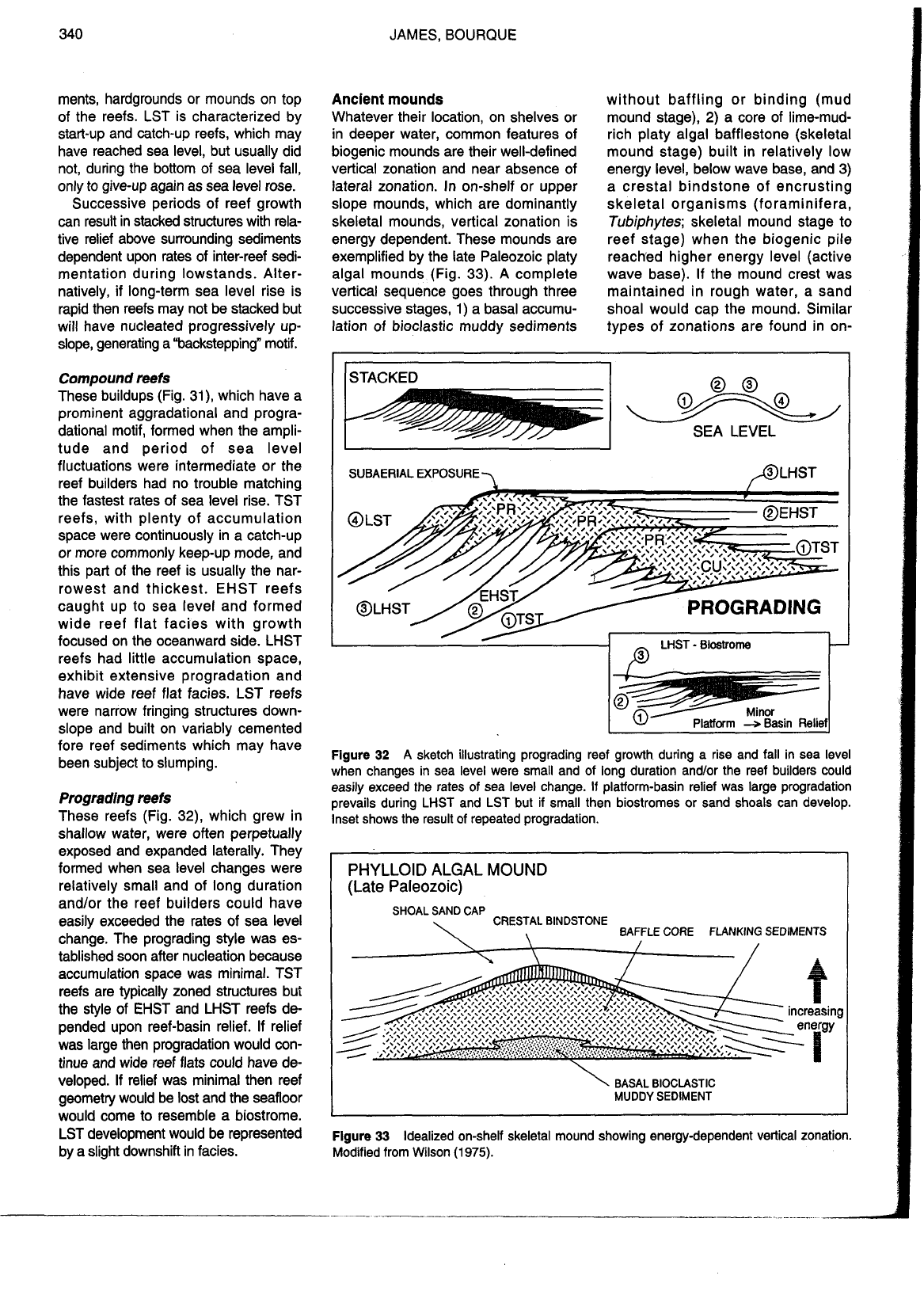
340 JAMES,
BOURQUE
ments, hardgrounds or mounds on top
of the reefs. LST is characterized by
start-up and catch-up reefs, which may
have reached sea level, but usually did
not, during the bottom of sea level fall,
only to give-up again as sea level rose.
Successive periods of reef growth
can result in stacked structures with rela-
tive relief above surrounding sediments
dependent upon rates of inter-reef sedi-
mentation during lowstands. Alter-
natively, if long-term sea level rise is
rapid then reefs may not be stacked but
will have nucleated progressively
up-
slope, generating a "backstepping" motif.
Compound reefs
These buildups (Fig. 31), which have a
prominent aggradational and
progra-
dational motif, formed when the ampli-
tude and period of sea level
fluctuations were intermediate or the
reef builders had no trouble matching
the fastest rates of sea level rise. TST
reefs, with plenty of accumulation
space were continuously in a catch-up
or more commonly keep-up mode, and
this part of the reef is usually the nar-
rowest and thickest. EHST reefs
caught up to sea level and formed
wide reef flat facies with growth
focused on the oceanward side. LHST
reefs had little accumulation space,
exhibit extensive progradation and
have wide reef flat facies. LST reefs
were narrow fringing structures
down-
slope and built on variably cemented
Ancient
mounds
Whatever their location, on shelves or
in deeper water, common features of
biogenic mounds are their well-defined
vertical zonation and near absence of
lateral zonation. In on-shelf or upper
slope mounds, which are dominantly
skeletal mounds, vertical zonation is
energy dependent. These mounds are
exemplified by the late Paleozoic platy
algal mounds (Fig. 33).
A
complete
vertical sequence goes through three
successive stages,
1) a basal accumu-
lation of bioclastic muddy sediments
without baffling or binding (mud
mound stage),
2) a core of lime-mud-
rich platy algal bafflestone (skeletal
mound stage) built in relatively low
energy level, below wave base, and 3)
a crestal bindstone of encrusting
skeletal organisms (foraminifera,
Tubiphytes;
skeletal mound stage to
reef stage) when the biogenic pile
reached higher energy level (active
wave base). If the mound crest was
maintained in rough water, a sand
shoal would cap the mound. Similar
types of zonations are found in
on-
SEA LEVEL
PROGRADING
fore reef sediments which may have
Figure
32
A
sketch illustrating prograding reef growth during a rise and fall in sea level
been subject to slumping.
when changes in sea level were small and of long duration
andlor the reef builders could
easily exceed the rates of sea level change.
If
platform-basin relief was large progradation
Prograding reefs
prevails during
LHST
and
LST
but if small then biostromes or sand shoals can develop.
These reefs (Fig. 321, which grew in
Inset shows the result of repeated progradation.
shallow water, were often
uerpetually
exposed and expanded laterally.
he;
formed when sea level changes were
relatively small and of long duration
and/or the reef builders could have
easily exceeded the rates of sea level
change. The prograding style was es-
tablished soon after nucleation because
accumulation space was minimal. TST
reefs are typically zoned structures but
the style of EHST and LHST reefs de-
pended upon reef-basin relief. If relief
was large then progradation would con-
tinue and wide reef flats could have de-
veloped. If relief was minimal then reef
geometry would be lost and the
seafloor
would come to resemble a biostrome.
LST development would be represented
by a slight downshift in facies.
PHYLLOID ALGAL
MOUND
(Late Paleozoic)
SHOAL SAND CAP
CRESTAL
BINDSTONE
,,,,,,,,,,,,,,,1,
MUDDY SEDIMENT
Figure
33
Idealized on-shelf skeletal mound showing energy-dependent vertical zonation.
Modified from Wilson
(1
975).
